A Quarter Of Iranian Farmers Unemployed In Last Seven Years

A quarter of Iran’s farmers have lost their jobs in the past seven years mostly due to lack of water, a local media outlet reported Sunday.

A quarter of Iran’s farmers have lost their jobs in the past seven years mostly due to lack of water, a local media outlet reported Sunday.
Farhikhtegan newspaper quoted a report by the Statistical Center of Iran saying that between 2015 and 2022, the number of people employed in the agricultural sector shrank by 1.3 million, from 5.1 million to almost 3.7.
Iran has faced drought for most the past two decades, partly due to climate change, but the government has also grossly mismanaged water resources with failing to control inefficient use of underground resources and diverting water for industries.
Based on the report, unemployment for farmers has increased the migration rate from villages to the outskirts of cities causing the expansion of slum-dwellings.
While the oil-rich Khuzestan province in the south was also one of the most fertile provinces of Iran for food production, now it has the highest number of slum-dwellers in the country.
Based on estimates, roughly 14 million Iranians live in slums and Khuzestan ranks first with 1.75 million slum dwellings.
In the summer of 2021, citizens protested the water crisis in 11 cities in Khuzestan.
Farmers in the provinces of Esfahan and Chaharmahal and Bakhtiari held similar rallies to protest “draught, lack of water, and the loss of livestock” but the regime’s security forces used violence to end the protests.
Farhikhtegan quoted city officials as saying that “the increase in population on the outskirts of cities has caused an imbalance in urban development leading to a surge in crime rate.”
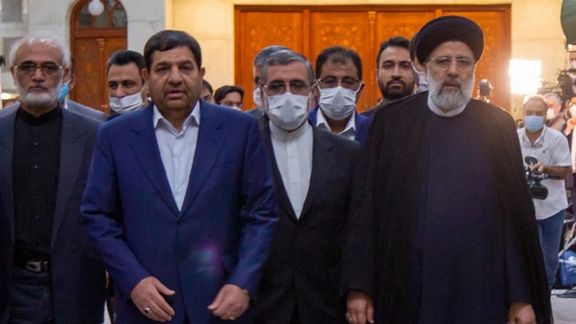
Iran faces a serious shortage in medicines with some prices rising sevenfold, months after the government eliminated cheap dollars for importing raw materials.
The crisis in health care is just one aspect of the overall economic crisis, precipitated by a centralized and often mismanaged economy, and for the past years, US sanctions.
Most medicines in Iran are produced locally by quasi-governmental companies that import the raw material from other countries. When the Iranian currency began to lose value in early 2018, the government offered a fixed exchange rate for essential goods, mainly food and medicines. However, earlier this year, the new administration of President Ebrahim Raisi eliminated what was in fact a government subsidy. Now, food and medicine producers must buy dollars at rates seven times higher to import their raw materials, which has disrupted production.
Deputy chairman of pharmaceuticals producers, Ali Fatemi told Aftab News in Tehran that when an economic sector is controlled by the government and is managed according to “a command economy” it is not surprising that a situation like the current shortage would emerge. The government sets unreasonably low prices and then stops subsidies, which makes it impossible for its companies to but raw materials and produce, he said.
To partially alleviate the shortage, the Iranian government allows medicines, such as antibiotics and simple cough syrups to be imported from India, Fatemi explained, and as a result the country spends much more foreign currency, instead of importing the raw materials.

Apart from pharmaceuticals, inflationary recession has gripped other sectors, according to Fararu website in Tehran. As prices have risen at least by 40 percent for two consecutive years, consumers have lost their purchasing power and demand has fallen. This has led to a “domino effect for producers and factories” that must stop operations. This in turn creates more unemployment and less consumer demand.
Iran’s currency has fallen by more than 15 percent since early September when it became clear that a nuclear agreement with West was not a realistic expectation.
Since early 2018, when the United States signaled its intention to withdraw from the 2015 nuclear deal known as the JCPOA, Iran’s rial has fallen tenfold from 35,000 to the dollar to 350,000 on November 12. When the US did withdraw from the accord in May of that year, it imposed damaging oil and banking sanction on Iran. This further devalued the rial and led to very high inflation, which coupled with the inefficiencies of a government-controlled economy, has impoverished tens of millions of people.
Ehsan Soltani, an economist in Iran told the website that while food prices have risen eightfold since 2018, wages, at most, have increased threefold.
“In recent years with rising inflation, economists warned officials about ‘inflationary recession’, but the government did not pay attention at all,” Soltani explained.
In fact, from cautious statements by many officials, especially in the previous Iranian government headed by President Hassan Rouhani, it was apparent that they were aware of the dire situation, but they had no control over the country’s foreign policy, which had brough about crippling US sanctions.
But Iran’s 83-year-old anti-Western ruler, Ali Khamenei, has the last word on foreign policy and only he could allow a new nuclear deal to be signed that would lift the most damaging sanctions.
Iran’s economic growth in the past decade has been zero and Soltani compared Iran to its neighbor Turkey. “Just look at Turkey…and see the high rate of growth it has achieved in the past ten years, adding tremendously to its foreign currency revenues, while we have faced economic and infrastructure decay.”

An Iranian member of the parliament says those who toss the turbans of clerics in Iran will see the result of their act as they are “playing the lion’s tail.”
Mohammad Taghi Naghd Ali said the turban-tossing protest movement in recent weeks is a “conspiracy of the devils.”
“Clergymen may bear with it and be patient, but those who play with the lion's tail must be aware they would face the music,” noted the representative of Khomeini Shahr in the Iranian parliament, not elaborating further.
Tossing the turbans of clergymen as they are walking in streets is now part of the current wave of antigovernment protests across Iran, which started as a reaction to the death of 22-year-old Mahsa Amini in custody of hijab police. Younger Iranians tired of government attempts to force them to observe the mandatory Islamic dress code and a restricted lifestyle, began protests and disobedience in mid-September.
The phenomenon has forced many clerics to tie their turbans under their chins or use other head coverings to keep them on their heads as they walk in the streets.
This new addition to the ongoing protests has caused a stir among regime officials and has even made Iraqi Shia cleric and politician Muqtada al-Sadr worried that the trend may spread to his side of the border as a form of protest to Islamic autocracy. He released a statement to condemn the act after many Iraqi young people started to dare their friends on social media to flip some turbans.
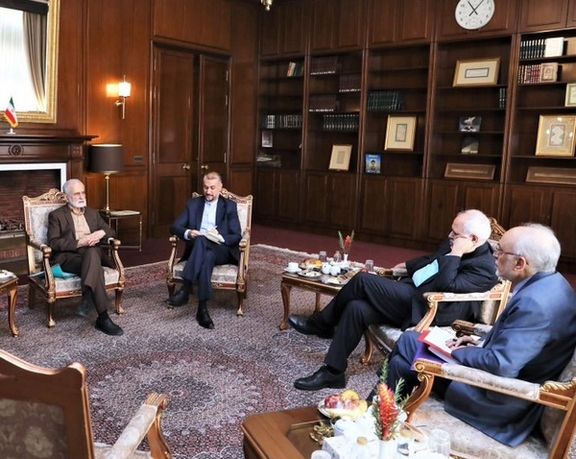
Iran’s Foreign Minister Hossein Amir-Abdollahian says he held a meeting with his four predecessors, including Mohammad Javad Zarif, without disclosing any details.
In a tweet late on Wednesday the Iranian top diplomat said, “in a friendly meeting I hosted the former foreign ministers of the Islamic Republic of Iran Kamal Kharazi, Manuchehr Mottaki, Ali Akbar Salehi and Mohammad Javad Zarif.”
Further he added that “We are determined to accomplish the objectives of the diplomacy in realizing the greatest interests of the nation by relying on collective wisdom.”
However, Amir-Abdollahian did not mention anything about the agenda of the meeting and the issues raised.
Some Iranian dailies, however, called the meeting “an urgent” one not giving any other details.
The meeting comes as negotiations to revive 2015 nuclear deal are in a deadlock, with the United States openly stating that the talks are not its focus at the moment.
The recent protests that have swept the country are having an undisputable impact on the chances of the revival of the JCPOA as it is getting more difficult for Washington and the West to negotiate with the Islamic Republic when anti-regime demonstrators are subjected to a brutal cracked down in the streets.
The United States and its European allies have warned Tehran to respect fundamental human and civil rights of the protesters and are threatening more sanctions.
It seems that the incumbent minister is seeking help from his predecessors to get the regime out of the impasse, but major policies in Iran are set by Supreme Leader Ali Khamenei.
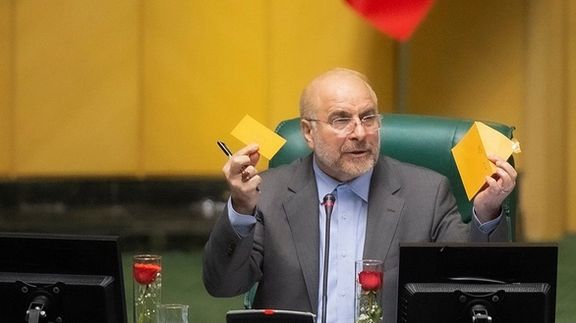
There are increasing indications that Iran's so-called neo-cons are attacking the ultraconservative Paydari Party to end its dominance in the Raisi government.
As columnist Mehdi Beigoghli noted in a commentary in the reformist Etemad newspaper, November 8, the neo-cons led by Majles (parliament) Speaker Mohammad Bagher Ghalibaf have been trying to convince others in Iran’s political circles that they are prepared to establish "new governance," and bring about "reforms in the system" based on "new plans."
These are the buzz words heralding change from within the system at a time when young men and women in the streets do not seem to be listening to anyone representing the regime.
Ghalibaf officially announced the move towards new governance earlier this week by saying, "I hope security will be completely restored in the country soon, so that legitimate and necessary changes would begin to establish a new governance in economic, social and political areas within the framework of the Islamic Republic."
This comes while according to Etemad, most observers in Iran believe a return to the situation before the murder of Mahsa Amini, a young Kurdish woman by ‘morality police’ in mid-September is impossible.
Nonetheless, neo-cons insist that once the country leaves behind the current wave of nationwide protests, everything will be ready for unseating the Paydari Party and changing all the cabinet ministers they believe Paydari strongman Saeed Jalili has imposed on the Raisi administration. At the same time, Paydari members in the parliament and in government keep calling for harsher measures against the protesters, possibly because they do not want the situation to calm down.
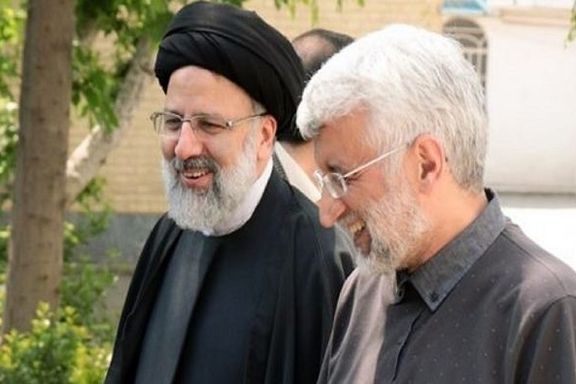
Another neo-con who spoke about reforms was Tourism Minister Ezzatollah Zarghami who believes Paydari's excessive pressure to limit freedoms, most notably from within the ‘morality police’ led to the current unrest. Meanwhile he pointed at systematic flaws in the political structure that need to be changed. He also argued that the neo-cons are ready for reforms once the protests calm down.
On the other hand, according to Etemad, Paydari members believe that any change in the previously declared policies will be taken by the public as a humiliating retreat by the hardliner government.
The conservative Resalat newspaper, which traditionally represented the political ideas of heavyweights in Tehran's Bazaar, has aligned itself with Ghalibaf. In its Tuesday's edition, the paper came out in support of the Speaker’s views about making government-controlled media more active rather than focusing on confrontations with foreign-based Persian media. It also attacked Paydari's leading member Morteza Agha Tehrani for calling for a total ban on social media.
Tuesday morning Ghalibaf attacked two leading Paydari members, Vice President and Planning and Budget Organization Chief Massoud Mirkazemi and Economy Minister Ehsan Khandouzi for failing to report to the parliament and explain their approach regarding the country's economic crisis. He called on them to report to the Majles immediately and they did. Mirkazemi on his part blamed the problems partly on the Majles. The whole show, however, revealed that Ghalibaf had the upper hand in the dynamics.
According to Etemad, the neo-cons may be using the situation of protests as an opportunity to attack the ultraconservatives at their weakest point by blaming them for most of the country's problems. At the same time, some observers say the divide between the two most powerful factions of Iran's conservative camp might be a division of roles with the aim of playing a good cop, bad cop game for the public.
While all this means that part of the Iranian government is prepared to introduce minor reforms in the system, protesters have shown during the past seven weeks that they are not prepared to settle for anything short of a regime change.
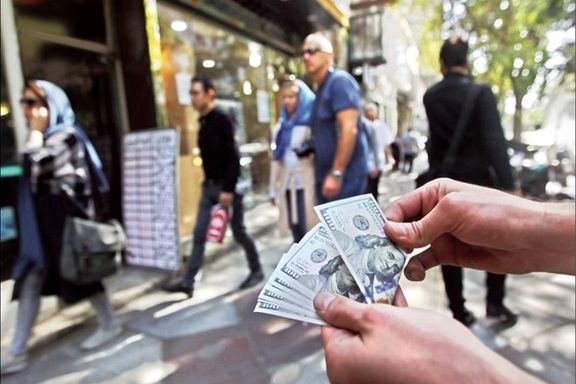
Iran’s national currency has lost 16% of its value during the past week, as the government prepares to submit next year’s budget bill to the parliament soon.
Iranian government’s annual budgets have faced annual deficits of at least 30 percent since 2019, when the United States imposed sanctions on the country. During this time, the government had to borrow more heavily from domestic banks, especially the Central Bank, and other financial entities to fill the budget gap.
Another major government revenue source is profits it makes when the rial loses value against major currencies, enabling the government to sell its foreign currencies at higher prices in open markets and pay salaries and other obligations.
According to the International Monetary Fund’s latest report, released on October 31, thanks to higher oil exports and prices, Iran’s total exports is expected to increase by 41% year-on-year to above $121 billion in 2022. For comparison, the figure was only $54 billion in 2020.
Of course, this figure is an estimate, since official information about how much oil Iran exports and how much foreign currency it actually receives remain state secrets, due to US sanctions.
On the other hand, Iran’s trade turnover balance is expected to stand at plus $35 billion this year, or three times more than in 2021. This value is equal to 81% of Iranian government’s budget, based on the current USD rate in Iran (1USD:367,500 rials).
The Iranian rial has lost about 47% of its value since July 2021, when the new government, headed by Ebrahim Raisi took office.

Regarding the fact that Iranian government’s oil exports during the current fiscal year (started March 21) is estimated to be above 1 million barrels per day (mb/d) or 40% more than last year, with higher global oil prices, its revenues have increased significantly.
Therefore, the government should have enough foreign currency reserves to prevent the de facto devaluation of the rial.
Iran’s oil exports had dropped to around 200,000 barrels a day in 2019-2020 during the Trump Administration which was hawkish in sanctions enforcement. As soon as Joe Biden was elected president, Iran began shipping more oil to China and the daily exports quadrupled by 2022.
Figures published by the central bank show government borrowing from this bank has not increased since July 2021, despite concerns by economists that more money needs to be printed to finance government operations.
However, central bank figures also show that liquidity has increased by 12% during this period, a fact that indicates the government continues printing money in huge amounts, most probably due to selling of foreign currencies at higher rates to the banks and exchange markets.
IMF predicted that Iran’s broad money growth to stand at 47.5% in 2022, 8.5% more than 2021.
This leaves many questions unanswered. If Iran has tripled its exports in two years, why the currency is falling and why It has such high budget deficits. Just this week, the government announced that Supreme Leader Ali Khamenei has authorized the use of more foreign currency reserves to bridge the deficit.
A Supreme Accounting Office report covering the period March 21- May 20 showed in July that except tax revenues, all other major sources of income grossly underperformed.
The government realized just 37 percent of the projected budget revenues in this period, but the most notable number in the report was how little oil income was collected. While 79 percent of tax revenues were realized, only 15 percent of oil export income entered government coffers. While barter of oil for goods is one possible explanation, rosy predictions about cash in government pockets might be misleading.
This remains another unanswered question, that outsiders like the IMF may never be able to figure out.